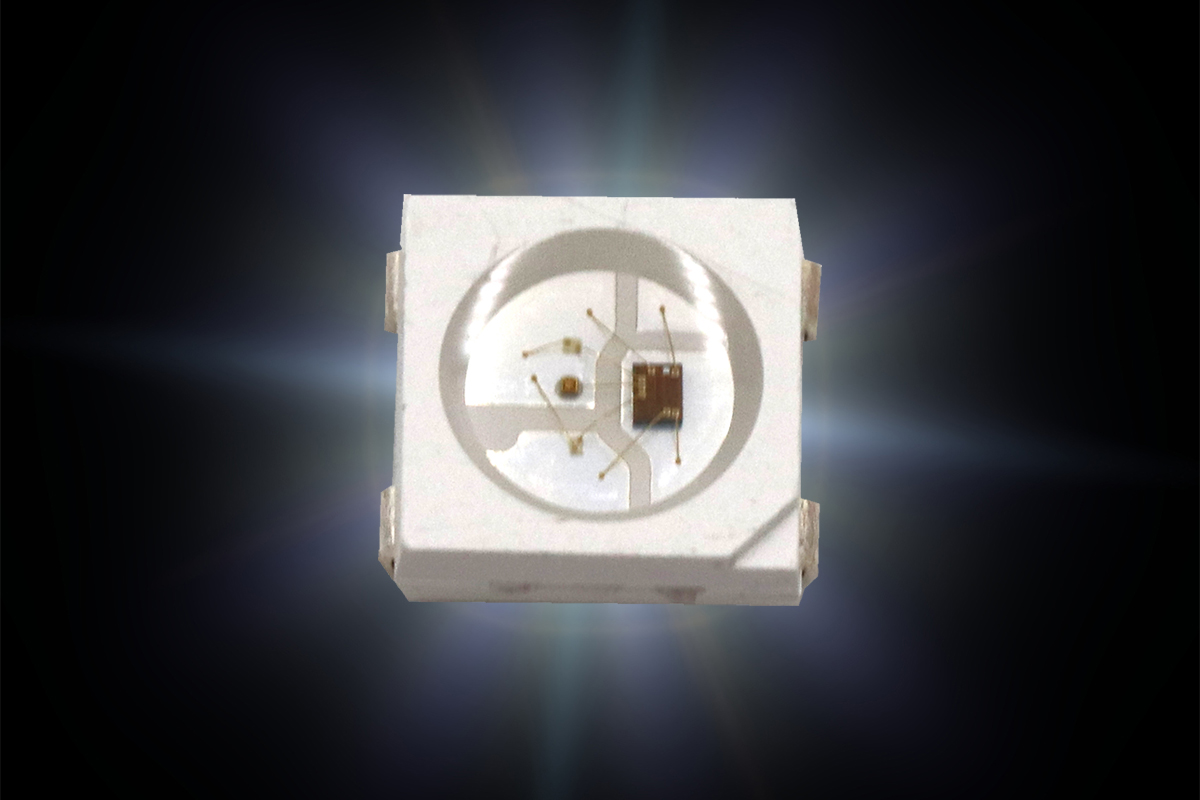What is an individually addressable LED
An individually addressable LED is a package-scale
LED light engine that integrates one or more LEDs with associated driver and control circuitry into an
SMD LED assembly. The
LED driver in addressable LEDs regulates electrical power (voltage and current) to ensure that each LED receives the correct amount of power to operate optimally. It is equipped with control circuitry that works with specific communication protocols, decodes digital signals, manages the addressing of individual LEDs, controls color mixing and brightness, and ensures the accurate transmission of data to create dynamic and programmable lighting effects.
Independence and intelligence
The companion driver and control IC (Integrated Circuit) gives an individually addressable LED independence and intelligence. The LED assembly has the same four-pin package as most non-addressable (also referred to as analog, standard or conventional)
RGB LEDs, but instead of RGB+, these four pins are anode, cathode, data in, and data out. Unlike conventional LEDs that are connected to the same power source across a circuit and control are generally set to the same color and brightness level, individually addressable LEDs can be controlled individually. This means that each LED can be dimmed or tunned on/off, allowing for pixelated lighting effects and dynamic animations across an array of LED. Conventional LEDs on the same circuit provide a fixed lighting output. Changes in color or brightness require adjusting the entire group simultaneously.
Color configuration
Individually addressable LEDs are generally designed for additive color mixing applications. The most basic color configuration is RGB (Red, Green, and Blue). Different intensities of RGB colors are combined to create light with a desired spectral power distribution (SPD), which we perceive as a secondary color. To achieve a broader color gamut, additional color channel is added to a mixture. RGBW adds white to the mix, extending the hue, saturation and brightness values available in the color system. RGBA adds amber to the mix and thus expand the available range of colors to include warmer tones such as rich gold, yellow, and orange shades. RGBWA LEDs can produce deep yellows and oranges, saturated reds, a full range of pastels, as well as high quality whites.
LED controller
Individually addressable LEDs are typically controlled by external microcontrollers or specialized
LED controllers. The LED driver in addressable LEDs addresses each LED based on its unique identifier, allowing for independent control. It receives input from the microcontroller or specialized LED controller. This input is in the form of a digital signal that contains information about the RGB value and brightness settings for each LED in the package. The control circuitry within the LED driver decodes the incoming data signal. The LED driver processes the data sequentially, ensuring that each LED in the chain receives the correct information. Some
LED drivers may include feedback mechanisms to detect errors or anomalies in the data transmission. This can help ensure the reliability of the control process. The LED driver often supports dimming functionality. Pulse-width modulation (PWM), which modulates the on-off time of an electrical signal to control the average power delivered to an LED, is often used to independently control the intensity of red, green, and blue LEDs (or other color channels) in addressable LEDs.
Communication protocol
The LED driver in addressable LEDs uses specific communication protocols to receive and interpret digital control signals. These protocols define how data is structured and transmitted to the LEDs. Digital communication between the LED driver and microcontroller typically occurs through a one-wire digital protocol, where data is sent to each LED in sequence. WS2812, WS2812B, WS2813, WS2815, SK9822, SK6812 and SK6813 LEDs use one-wire protocols (WS2815 additionally has a backup data line for improved reliability. Serial Peripheral Interface (SPI) is another popular interface bus commonly used to send data between microcontrollers and addressable LEDs. It uses separate clock and data lines to enable high refresh rates and precise color control. SPI is designed to address applications where timing and synchronization are critical. Two-wire SPI uses only two wires: a clock line (SCK) and a data line (MOSI). In a three-wire SPI configuration, an additional slave select line (SS) is introduced to transmit data from one LED to the next in a daisy-chain configuration. APA102, LPD8806 and SK9822 use a two-wire SPI. WS2801, WS2812 and WS2812B use a three-wire SPI configuration.
Different brands of individually addressable LEDs may use varied communication protocols. Choose a microcontroller platform that supports the protocol. Microcontrollers, such as Arduino boards, Raspberry Pi, ESP8266, ESP32, or dedicated LED controllers, generate the digital signals that determine the behavior of the LEDs. They can be programmed to execute specific tasks or generate complex lighting effects, animations, and dynamic color changes using LED libraries and software frameworks. Arduino is widely used to control
individually addressable LED lighting products for its ease of use and extensive community support. Raspberry Pi is a single-board computer which offers more processing power for more complex tasks and applications. The ESP8266 and ESP32 are both low-cost, microcontrollers with integrated Wi-Fi connectivity. They are popular choices for hobbyists and makers to create
IoT devices.
